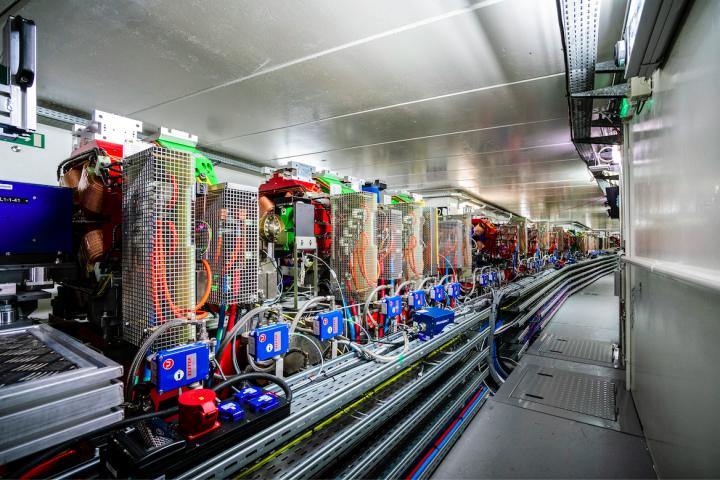
Credit: ESRF/stef Cande
2 December 2019 – The first electrons have been injected in the new ESRF Extremely Brilliant Source storage ring according to schedule. This is an important milestone on the way to opening to the international scientific community the first high-energy fourth-generation synchrotron light source, known as EBS – Extremely Brilliant Source. It marks the successful completion of the engineering and installation of a worldwide-unique accelerator within the existing ESRF infrastructure, and the start of the commissioning phase of a brand-new generation of high-energy synchrotron.
Expectation was high in the ESRF’s control room on 2 December as teams carefully monitored the first turns of the electrons around the new EBS storage ring.
“Seeing the first electrons circulating is a huge achievement and proof of the hard work and expertise of the teams who have been working on this since 2015,” said Pantaleo Raimondi, ESRF accelerator and source director and EBS storage ring concept inventor and project leader. “It’s a great moment for all involved.”
“It’s a proud day for the whole synchrotron user community,” said Francesco Sette, ESRF Director General. “EBS is now coming to life. It’s an important milestone on the way to a new generation of hard X-ray sources, which will provide the international scientific community with an indispensable tool to push back the frontiers of science. I would like to thank all the ESRF staff and international teams who have worked tirelessly to make this possible on time and within budget. I would also like to thank our 22 partner countries for their strong and constant support, allowing ESRF to fulfil its global mission of pioneering synchrotron science.”
Following the achievement of first injected electrons, the team will work hard over the next few weeks to optimise the parameters of the beam, ramp up the current and use the beam to condition the storage ring vacuum system.
The next steps are the following:
- – storage ring commissioning to obtain the beam parameters required to restart the experimental programme by 2 March 2020,
– further storage ring commissioning and experimental programme restart from 2 March to 24 August 2020,
– resumption of the User Service Mode on 25 August 2020.
EBS, the first high-energy fourth-generation synchrotron
EBS is a 150 million-euros,¬ ESRF upgrade programme over 2015-2022, highlighted as a landmark in the ESFRI (European Strategy Forum on Research Infrastructures) roadmap and centred around the construction of a brand-new synchrotron source, based on a novel storage ring concept fully developed at the ESRF. State-of-the-art beamlines, an advanced instrumentation programme and a data-management implementation plan – required for the efficient exploitation of the new source – complement the programme.
Established in 1988 and inaugurated in 1994, the ESRF was the first third-generation synchrotron – a new generation of X-ray sources improving previous source parameters by a factor of 100 to 1 000. With EBS, the ESRF is replacing its previous third-generation source with a ground-breaking new high-energy fourth-generation machine that will again increase previous source parameters – in particular the brilliance and coherence of the X-ray beams – by at least a further factor of 100. The EBS breakthrough design performance relies on the efficient realisation of a very low-emittance Multiple Bend Achromat (MBA) storage ring, a concept which has been discussed since the 1990s. The new and original EBS concept is based on a Hybrid Multiple Bend Achromat (HMBA) lattice design, which is now paving the way to a new generation of synchrotrons worldwide.
EBS relies on a number of key innovative technologies. This first-of-a-kind new storage ring combines an increase to seven – compared to two previously – bending magnets per cell with an original magnetic optics design that simultaneously maximises the stable phase space volume available for the electron beam and drastically reduces the horizontal emittance. The result is a much tighter transversal packing of the electron bunches, increasing the brightness and degree of coherence of the X-rays by two orders of magnitude. EBS also uses permanent magnet technology for 128 dipole magnets, significantly reducing synchrotron radiation waste and achieving a significant 20-30% reduction in wall-plug electricity consumption. EBS solves a decades-long puzzle for the implementation of stable and highly performing diffraction-limited high-energy storage rings, and makes the ESRF-EBS storage ring the first high-energy fourth-generation synchrotron light source.
A new dawn for X-ray science
The enhanced X-ray performances of EBS will provide new tools for the investigation of materials and living matter from the macroscopic world down to the nanometre scale, and hopefully to the direct imaging of conglomerates of a few atoms.. It will thus allow scientists to probe complex materials in greater detail, with higher quality, and much faster, sparking new research opportunities in fields such as health, energy, environment, new sustainable and innovative materials, but also cultural heritage and palaeontology.
A scientific, technical and human challenge
During a 20-month technical shutdown that began on 10 December 2018, teams removed nearly 2000 tonnes of components from the storage ring tunnel and installed the new EBS storage ring. The new ring comprises over 10 000 individual components, each precision-aligned to within 50 microns (about the width of a human hair) over the 844-m storage ring length. ESRF experts now face the challenge of bringing the new machine up to operating conditions in three months, when work will begin to restart the facility’s fleet of beamline instruments, with the aim to open a maximum of beamlines to international scientific users for the user programme restart planned on 25 August 2020.
As explained by Francesco Sette, DG of the ESRF, “the EBS programme aims to ensure ESRF remains a pioneer in synchrotron science for the decades to come, efficiently re-uses 90% of previously existing infrastructure, and addresses best practices to lower the ESRF carbon footprint.”
###
Media Contact
delphine chenevier
[email protected]
33-060-716-1879
Original Source
https:/




